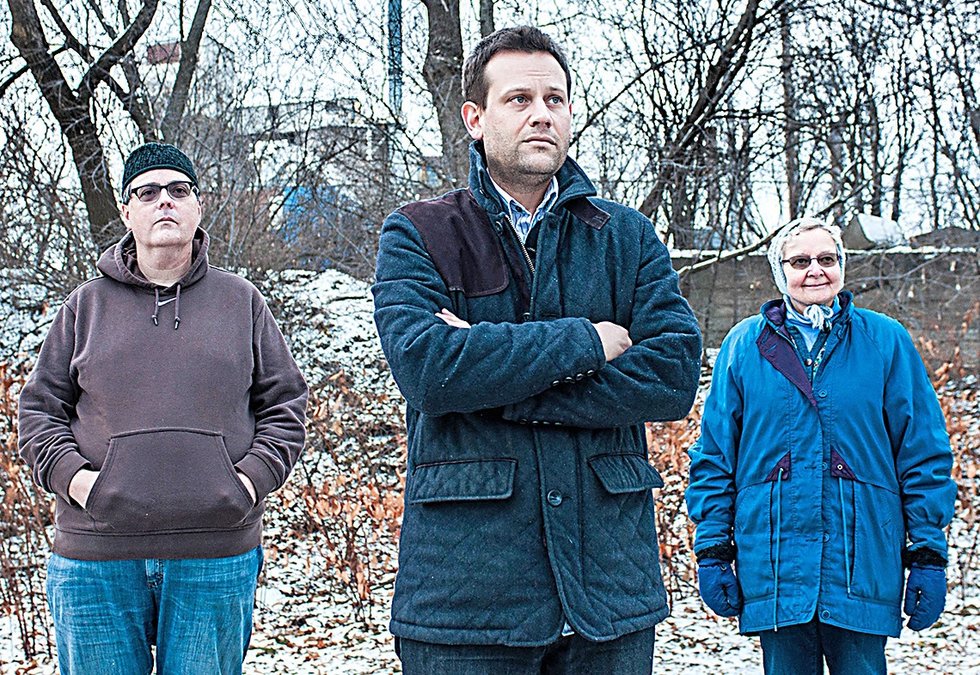(First published in the December 6, 2018 issue of City Pages)
An outside toxicology expert says Wausau is ignoring dangerous levels of chemicals in the ground around Thomas Street.

From left, Anders Tietz, Tom Kilian and Joyce Luedke, members of the Citizens for a Clean Wausau, at Riverside Park. The group is pushing for further testing for dioxin levels at the park, just off Thomas Street
A toxicology expert suggests Wausau’s testing of dioxin levels on Thomas Street ignored the potential cancer risk of pollution at the site.
In a response to a request for his opinion from neighborhood resident Tom Kilian and the Citizens for a Clean Wausau, national toxicology expert Stephen Lester in a letter stated that testing done by two state toxicologists who presented their findings to the city council earlier this year was severely flawed. The testing failed to measure for cancer risk and used the site with the second highest level of contamination, not the highest, as the basis of its risk assessment. And that dioxin levels found are above the standard that would be cleaned under a Superfund site, Lester says in the letter.
Contamination on Thomas Street corridor has been a hot button issue for years and gained momentum this year as the city has for nearly a decade been working on rebuilding the street. The city completed the west end of Thomas Street last year, and hopes to start construction next year on the east end, up to the bridge over the Wisconsin River.
But the contamination issue has taken on a life of its own, with the group Citizens for a Clean Wausau forming in June around the issue.
State toxicologists in May told city leaders that they found no levels of dioxin that indicated concern, saying that a person who ingested soil from the nearby Riverside Park three days per week in non-snow covered months would still have safe levels of dioxin.
Mayor Robert Mielke says that the city has decided not to complete additional testing on the Thomas Street corridor, and isn’t likely to at the park either, despite the letter. Mielke says the reason the site was tested in the first place is because the soil tested above the EPA’s screening levels, and hadn’t been tested in 14 years. He says that the state toxicologists’ reports and findings are sufficient.
But other council members say they now back more testing in light of Lester’s letter. “People have legitimate concerns as was evidenced at the recent meeting, and I think it would be good to respect those concerns and look further into them” Council Member Tom Neal told City Pages this week.
Neal at an earlier parks meeting voiced support for more testing. “As it applies to the park, I would support a broader testing effort. It’s best to know for sure what may or may not be a significant hazard, not only for users of the park, but also as it relates to the river.”
Alderman Gary Gisselman after Monday’s Parks and Recreation Committee meeting told City Pages that he is urging city officials to figure out what committee should address the testing and get it on an agenda. “We need to move this forward so that there is some result,” Gisselman says.
Killian also proved persuasive at the city’s Economic Development Committee meeting Tuesday night in garnering support for testing at the former business incubator site. Community Development Director Chris Schock says the city wants to seek proposals for the property at 1301 Cleveland Avenue, which the city has owned for nearly 25 years.
But after hearing a speech from Kilian, who detailed its industrial uses and says toxic waste was dumped there decades ago, city leaders said they wanted to see Phase I environmental testing done on the site before seeking proposals for the site. City Council Chair Lisa Rasmussen says it doesn’t make sense to garner interest from, say, a housing developer if it turns out the site is too contaminated for housing in the first place. And Economic Development Committee Chair Tom Neal says it makes sense to know if it’s contaminated, since it’s part of the city’s inventory.
Schock says that city staff decided that it would make sense to see if there were any interest in site before spending the money to test, but would seek out the testing for the site at the committee’s request. Phase I testing usually cost a few thousand dollars, he said.
NOTE: This story has been updated with the correct spelling of Tom Kilian’s name.




